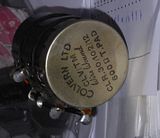Okay, here's what I found on the real BC-2B with 1K sine wave tones. I followed this with a listen to program material at all settings, and the response seemed to stay remarkably flat. I didn't do sweeps to judge any response changes. later revisit in red
feedback R / feedback amount
open / none
2.12M / 3.5 db
1.33M / 5.1 db
880K / 6.9 db
470K / 10.2 db (40 db stock)
290K / 13.3 db
180K / 16.5 db
120K / 19.5 db good down to here with stock NFB cap
80K / 22.5 db
50K / 25.9 db good down to here with NFB cap changed to 0.47mfd
30K / 29.3 db
20K / 32.3 db
I don't think I'd personally trust stepping the gain down to those last two steps via feedback, but it seemed okay. In comparison, the BA-11A has 27 db of feedback, so it's not terribly out of range. I'd probably personally go +10 to -15 with the feedback, using a stepped switch so I know where the stock sound setting lives.
I doubt you'll overload a stock BC-2B input transformer; open question for anything else. You won't (sanely) overload that LS-10 if you use it.
The K & K audio kit appears to use both an input pad and a stepped pot on the input transformer secondary. I'd think you could safely go with 6-10 db of stepped loss on the input secondary; probably depends agin on the input trans quality.
The K&K mention of original BC-2B module price is now seriously outdated, BTW.
For any other antique pre you want to try, simply disconnect the feedback and take gain and resistance measurements with a variable resistance sustituted for the fixed feedback resistance. It's really that easy. Be prepared to sub larger caps in the feedback path and/or audio path for continued flat low frequency response at higher feedback quantities.
There are later (late 50's-60's) tube preamps that have really high amounts of feedback to help make up for the use of smaller, cheaper, lower quality iron, and it can be a real eye opener to pull the feedback out and hear them go to sh*t. Many of the early 50's units were still using iron that sounded good with or without feedback as part of their corrective massage, and you can make more changes with them.
As far as input and output attenuators, Dave has left a lot of good advice already. Standard 20 db pad on the front and any version of T, H, L, or pot on the out will work. Many people get away with a 1K pot for output, though I like to splurge for proper T attenuators personally. Most L's will automatically give you a 6db loss unless you also wire in a bypass switch.
Final note; I measured the step down through a stock BC-2B output transformer at -18.6db, which suggests a higher primary than 15k. My gut tells me that RCA used 25K-30K for most preamp outputs (as did Western Electric), but I know I shouldn't necessarily trust my gut on this one. :grin: Some RCA tube preamps have output trans step down as high as -22 db. The 15K will work just fine, though.
LATER ADDENDUM:
[quote author="NewYorkDave"]
someone on Usenet who owns an original BC-2B measured his preamp transformers as 30/150:33.7K input and 12K:600 output.[/quote]
I had an NOS/NIB input xfrmr once, and the RCA box stated 30 ohm is 1:46 ratio, 150 ohm is 1:20.5 ratio. That would appear to be a 63K secondary.
12K:600 for the output would be only a 13 db ideal loss. Most 15K:600 outputs I've checked measure close to a perfect 14 db loss. I measured 18.6 db loss through the output (BA-11A in operation with 1K tone) with a 620 ohm load on the 600 ohm secondary. Not accounting for losses, that would appear to be roughly 42K:600. Considering 1.1db of winding loss, that would translate into 33K:600, and a 2 db winding loss would be 27.5K:600. Looks closer to my gut feeling expressed earlier.
More:
http://www.groupdiy.com/index.php?topic=21504




